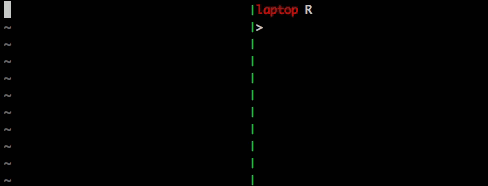vim-slime
Demo
What is Vim-Slime?
Context for SLIME:
SLIME is an Emacs plugin to turn Emacs into a Lisp IDE. You can type text
in a file, send it to a live REPL, and avoid having to reload all your code
every time you make a change.
Vim-slime is a humble attempt at getting _some_ of these features into Vim.
It works with any REPL and isn't tied to Lisp.
Grab some text and send it to a GNU Screen / tmux / whimrepl session.
VIM ---(text)---> screen / tmux / whimrepl
Presumably, your session contains a REPL, maybe Clojure, R or python. If you can type text into it, vim-slime can send text to it.
The reason you're doing this? Because you want the benefits of a REPL and the benefits of using Vim (familiar environment, syntax highlighting, persistence ...).
More details in the blog post.
Installation
I recommend installing pathogen.vim, and then simply copy and paste:
cd ~/.vim/bundle
git clone git://github.com/jpalardy/vim-slime.git
If you like it the hard way, copy plugin/slime.vim from this repo into ~/.vim/plugin.
Usage
Put your cursor over the text you want to send and type:
C-c, C-c --- the same as slime
You can just hold Ctrl and double-tap c.
The current paragraph, what would be selected if you typed vip, is automatically
selected. To control exactly what is sent, you can manually select text before calling vim-slime.
Vim-slime needs to know where to send your text, it will prompt you. Vim-slime will remember your answers and won't prompt you again. But if you need to reconfigure, type:
C-c, v --- mnemonic: "variables"
or call:
:SlimeConfig
Configuration
GNU Screen
By default, GNU Screen is assumed, you don't have to do anything. If you want to be explicit, you can add this line to your .vimrc:
let g:slime_target = "screen"
Because Screen doesn't accept input from STDIN, a file is used to pipe data
between Vim and Screen. By default this file is set to $HOME/.slime_paste.
The name of the file used can be configured through a variable:
let g:slime_paste_file = "$HOME/.slime_paste"
" or maybe...
let g:slime_paste_file = tempname()
WARNING: This file is not erased by the plugin and will always contain the last thing you sent over. If you're worried about this, you might consider switching to tmux.
When you invoke vim-slime for the first time, you will be prompted for more configuration.
screen session name:
This is what you put in the -S flag, or one of the line from "screen -ls".
screen window name:
This is the window number or name, zero-based.
tmux
Tmux is not the default, to use it you will have to add this line to your .vimrc:
let g:slime_target = "tmux"
When you invoke vim-slime for the first time, you will be prompted for more configuration.
tmux socket name:
This is what you put in the -L flag, it will be "default" if you didn't put anything.
tmux target pane:
":" means current window, current pane (a reasonable default)
":i" means the ith window, current pane
":i.j" means the ith window, jth pane
"h:i.j" means the tmux session where h is the session identifier
(either session name or number), the ith window and the jth pane
"%i" means i refers the pane's unique id
By default STDIN is used to pass the text to tmux. If you experience issues
with this you may be able to work around them by configuring slime to use a
file instead:
let g:slime_paste_file = "$HOME/.slime_paste"
" or maybe...
let g:slime_paste_file = tempname()
WARNING: This file is not erased by the plugin and will always contain the last thing you sent over.
whimrepl
whimrepl is not the default, to use it you will have to add this line to your .vimrc:
let g:slime_target = "whimrepl"
When you invoke vim-slime for the first time, you will be prompted for more configuration.
whimrepl server name
This is the name of the whimrepl server that you wish to target. whimrepl
displays that name in its banner every time you start up an instance of
whimrepl.
Advanced Configuration
If you need this, you might as well refer to the code :-)
If you don't want the default key mappings, set:
let g:slime_no_mappings = 1
The default mappings are:
xmap <c-c><c-c> <Plug>SlimeRegionSend
nmap <c-c><c-c> <Plug>SlimeParagraphSend
nmap <c-c>v <Plug>SlimeConfig
If you want vim-slime to prefill the prompt answers, you can set a default configuration:
" screen:
let b:slime_default_config = {"sessionname": "xxx", "windowname": "0"}
" tmux:
let g:slime_default_config = {"socket_name": "default", "target_pane": "1"}
If you want vim-slime to bypass the prompt and use the specified default configuration options, set the g:slime_dont_ask_default option:
let g:slime_dont_ask_default = 1
Language Support
Vim-slime might have to modify its behavior according to the language or REPL you want to use.
Many languages are supported without modifications, while others might tweak the text without explicit configuration:
